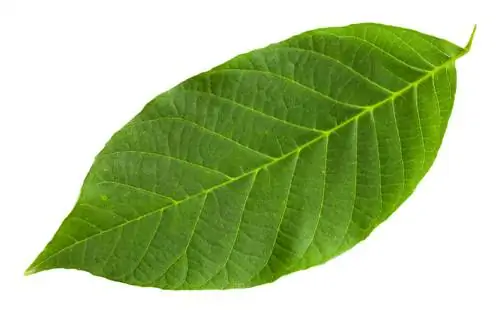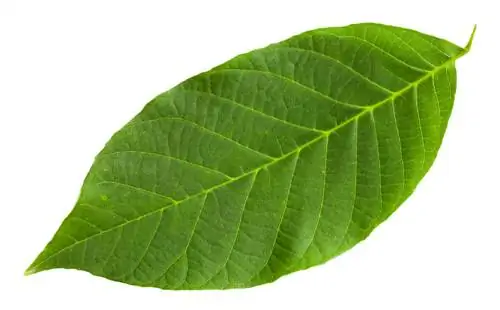- Author admin [email protected].
- Public 2023-12-16 16:46.
- Last modified 2025-06-01 06:02.
The leaves of the walnut tree are of great importance - for several reasons: They are vital for the plant itself and are not only absolutely attractive to humans, but also recommended as a medicine. In our guide you will find out everything you need to know about the leaves of the walnut, from their optical characteristics to their he alth-related applications.

What do walnut tree leaves look like and what are they used for?
The leaves of the walnut tree are imparipinnate, have a thirty to fifty millimeter long stem and seven to nine centimeter long leaflets in elongated oval to broadly elliptical shapes. When crushed, they give off an aromatic, turpentine-like smell and are used as a remedy for skin diseases and gastrointestinal complaints.
This is what the leaves of the walnut look like
The walnut tree has odd-pinnate leaves with a stem that is about three to five centimeters long. The seven to nine centimeter long leaflets can be shaped differently from elongated oval to broadly elliptical. They also have narrowed ends on both sides. The terminal leaflet is stalked and much larger than the other leaves.
The leaves of the walnut tree are reddish when they shoot. Later the color on the top changes to a strong medium or dark green. The leaves are lighter underneath and are only a little hairy in the corners of the nerves. In the autumn season the tone changes to a subtle, barely noticeable yellow-brown.
Smell of walnut leaves
When crushed, the leaves of the walnut give off an aromatic scent. They smell strongly of turpentine.
When the walnut turns green and becomes bare
“The first will be last.”
This saying applies to a certain extent to the walnut tree. It sheds its leaves early in autumn - and then takes a very long time until it sprouts again.
In spring, the walnut tree is the last deciduous tree to turn green - even after the oak. Often no leaves can be seen at the beginning of May.
Using walnut leaves as a medicine - tips
The leaves of the walnut tree are used as medicine - for internal as well as external use.
You can choose to use dried or fresh leaves. Walnut leaves are said to be particularly effective against skin problems. In addition, the leaves are said to help against bacteria, fungi and worms.
Here is an overview of some of the ingredients in the leaves:
- tannins
- Flavonoids
- Vitamin C
- Glycosides (juglone)
Tips for external use
For skin diseases such as eczema, psoriasis or athlete's foot, the leaves of the walnut tree are in the form of
- Bathrooms,
- Courses and
- Envelopes
helpful.
Tips for internal use
For skin diseases, but also for intestinal problems, it is often worth consuming walnut leaves as a tea.
How to make tea with the leaves:
- Pour a cup of boiling water over two teaspoons of walnut leaves.
- Let the whole thing steep for ten minutes.
- Strain the leaves.
- Drink the hot walnut tea in small sips.
Drink one to three cups daily. After six weeks of continuous use, you should take a break for several weeks and first enjoy another tea. You can then continue drinking walnut tea for another six weeks.
Note: The break prevents unwanted long-term effects and also prevents the positive effect from wearing off due to a habituation effect.
Walnut leaves effective against insects
The essential oils of the walnut leaves keep away unwanted insects such as flies, fleas, mosquitoes and moths. That's why walnut trees are often planted near seats in parks and near compost heaps in gardens.
Leaves are vital for the walnut tree
If a walnut tree no longer produces leaves, for example due to severe frost damage, it dies. The tree cannot live without leaves.






